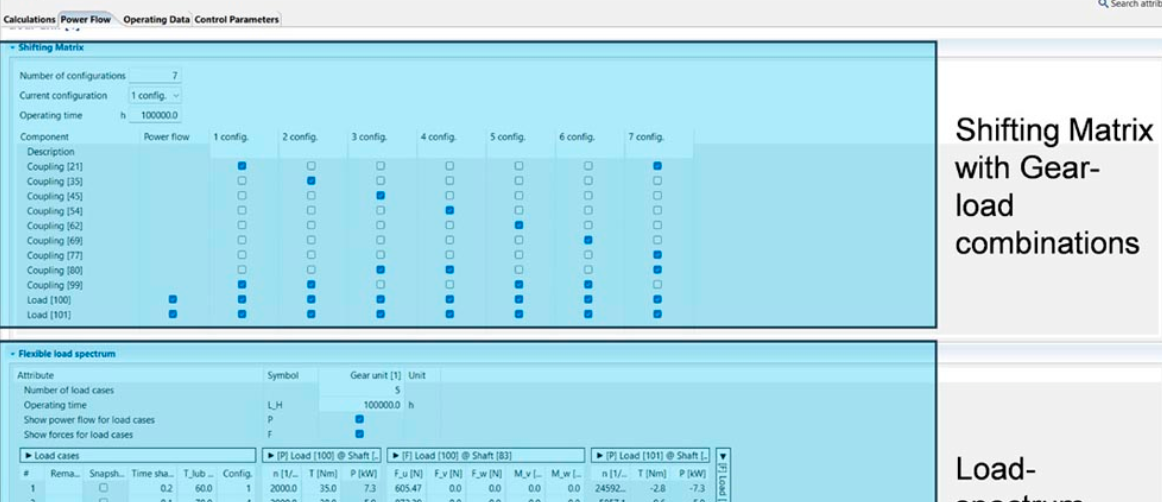Flexibility in Gear Design

Load collectives in the FVA-Workbench expand design capabilities.
Conventional gearbox designs based on nominal power and speed are generally not sufficient to meet the diverse requirements of modern applications, such as resource efficiency at high power density, high efficiency, and long service life. On the contrary, various operating states must be isolated and the combinations between them must be considered. This is done using load spectra.
These load spectra consist of scaling factors for speed and torque in the power flow. Aside from constant loads, all remaining loads in the system were scaled with the power flow.
With the current version of the FVA-Workbench, this feature has been expanded to include “flexible load spectra.” This makes it possible to create any combination of loads and switched gears with the associated time percentages in an intuitive editor.
A separate system calculation is performed for each of these load cases, followed by an additional accumulation of the load cases and their respective time percentages. This means that the user can subsequently evaluate the effects of the various operating states separately as well as the result of the entire calculation in FVA-Workbench reports.
Example Application: Rolling Mill Gearbox
The benefits can already be observed in the simple drivetrain of a rolling mill, the schematic of which is shown. The key data for the design originates from the FVA 131 research project.
Two important phenomena can occur during the rolling process: normal tapping or tapping with so-called chatter vibrations (see FVA 131). Here, we are only concerned with normal tapping; however, the process for consideration of chatter vibrations is similar. In greatly simplified terms, normal tapping consists of three operating states which are repeated every eight seconds:
Start of tapping
Rolling process
Idle
With the FVA-Workbench, these single-parameter as well as multi-parameter (i.e., with additional consideration of speed, external forces, etc.) time histories can easily be converted into load spectra for the system calculation.
In the next step, the calculations can be performed using the specified load spectrum.
Available Calculations
In FVA-Workbench 9, load spectra (both scaled and flexible) can be considered in the following calculations:
ISO 6336 2006 and 2019 for cylindrical gears
Gear excitation according to FVA 338 I for cylindrical gears
ISO 10300 2014 for bevel gears
Rolling bearing calculations
2012 FKM Guideline for shaft notches
Local damage accumulation for bevel gears
If desired, snapshots can be created for each load case with all associated results for reporting. This makes it possible to evaluate the individual load cases in the flexible load spectrum in isolation with all the other available calculation methods in the FVA-Workbench. This enables users to optimize gearboxes for the entire load spectrum as well as for the individual spectrum stages.
Conclusion
The new flexible load spectrum feature significantly expands the range of calculation and evaluation options in the FVA-Workbench. The key innovations are:
Individual forces and bending moments can be specified separately for each load case
The oil temperature can be varied for each load case
A report can be created for each individual load case
The benefits of the scaled load spectrum are also still available:
Specification of torque and speed for each load case
Constant individual forces and bending torques for all load cases
Switchable loads
A report with the accumulated results of all load cases
Can be controlled via FVA-Workbench scripting.
One final benefit of the scaled load spectrum is that it is possible to interpolate between the load cases, enabling the calculation of extensive load spectra with a high level of computational performance.
1.The news above mentioned with detailed source are from internet.We are trying our best to assure they are accurate ,timely and safe so as to let bearing users and sellers read more related info.However, it doesn't mean we agree with any point of view referred in above contents and we are not responsible for the authenticity. If you want to publish the news,please note the source and you will be legally responsible for the news published.
2.All news edited and translated by us are specially noted the source"CBCC".
3.For investors,please be cautious for all news.We don't bear any damage brought by late and inaccurate news.
4.If the news we published involves copyright of yours,just let us know.
BRIEF INTRODUCTION
Cnbearing is the No.1 bearing inquiry system and information service in China, dedicated to helping all bearing users and sellers throughout the world.
Cnbearing is supported by China National Bearing Industry Association, whose operation online is charged by China Bearing Unisun Tech. Co., Ltd.
China Bearing Unisun Tech. Co., Ltd owns all the rights. Since 2000, over 3,000 companies have been registered and enjoyed the company' s complete skillful service, which ranking many aspects in bearing industry at home and abroad with the most authority practical devices in China.


